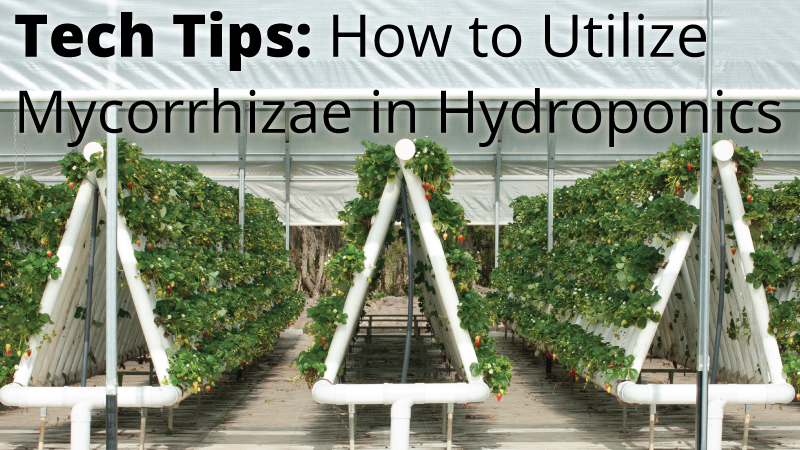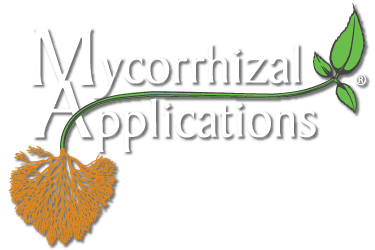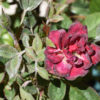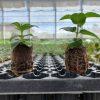
Today, we’re focusing on a question that keeps coming up more and more: “Can mycorrhizae benefit my hydroponic production?”
Let’s start by agreeing on a definition of hydroponics. According to the USDA, “Hydroponics is the technique of growing plants using a water-based nutrient solution rather than soil, and can include an aggregate substrate, or growing media, such as vermiculite, coconut coir, or perlite.” Hydroponics can be either indoors or outdoors. It can include a wide variety of plants and is not limited to typical controlled environmental agriculture or medicinal crops.
Some growers struggle to understand the “why?” and the “how?” someone would want to use mycorrhizae in a water-based nutrient-grown plant. Before I answer those questions, let me step back and review the role mycorrhizae plays in nutrient and water management in plants. Mycorrhizae are rhizosphere-based fungi that form symbiotic relationships with plants and expand the root absorptive area of the plant up to fifty times. This mutually beneficial relationship starts when the plant root senses the mycorrhizae propagule in the surroundings and releases an exudate to activate the mycorrhizae, which in turn attaches to the plant root. The propagule needs to be half an inch (1.3 cm) or less from the root tip. Endomycorrhizae actually enter the plant’s root cells, hence “Endo” and Ectomycorrhizae grow in between the plant’s root cells, hence “Ecto”. Once attached the mycorrhizae then start to develop a mycorrhizal hyphal network in the media and solution. These hyphae are typically one-tenth the diameter of a root hair and can extend up to twenty-four inches (61 cm) beyond where they are attached to the root.
Why to Use Mycorrhizae in Hydroponics:
The why a grower would want to grow with mycorrhizae can be answered with some additional details on how mycorrhizae work. Nutrient and water absorption occur along the entire length of the mycorrhizal hyphae, as opposed to a root and root hair that can only absorb at the tip. With mycorrhizae hyphae, mineral nutrient uptake occurs from the soluble and insoluble pools in the rhizosphere. Root and root hair uptake only occurs in the soluble nutrient pools. And finally, the rate of uptake is not limited like a root hair, leading to a greater inflow of water and nutrients with the partnership from mycorrhizal hyphae. Mycorrhizal plants can also uptake nutrients on the availability shoulders of plant nutrient availability, allowing you a little leeway in the management of your liquid media. Plants form symbiotic relationships with mycorrhizae to develop a more reliable source of nutrients and water (even in a hydroponic solution); resulting in less abiotic plant stress. Mycorrhizal plants also typically experience better overall plant health, and as such, the plant is better able to resist and fight off root diseases and insect issues.
How to Use Mycorrhizae in Hydroponics:
The how a grower would apply mycorrhizae is rather simple and does not vary from traditional plant production. Propagation is the step in the production process for mycorrhizal application in a hydroponic production system. Typically, this is when the seed is started, or the liner rooted. Both of these typically require some sort of structure for the new plant to begin its life. A mycorrhizal drench of the rock wool, coir, or Oasis cube should be all you need to do to start the symbiosis process. We suggest using one of the formerly mentioned starter media, so you don’t have to rinse off the roots like you would if you use a peat-lite mix. Once the seed germinates and/or the cutting starts to root, the mycorrhizae and the plant root will come in contact and the symbiosis process begins. Typically, this period lasts three to four weeks but can be quicker with some plant species/materials. As additional roots start to emerge, more mycorrhizal connections are established, and the plant and mycorrhizae are forever linked, throughout the life of the plant.
Crucial points to this process are: First, the relationship starts during a time the roots and the mycorrhizae are both in a structured environment (before being transferred to the hydroponic production process). And second, the plant and the mycorrhizae are given the time necessary for the initial foray of connections to be established before the plant is moved into the water-based nutrient solution. It is not impossible to get colonization in a full water system, but it takes much longer, and it is harder for the propagules to germinate and establish the symbiosis if the water is in constant flow/movement. Mycorrhizal Applications does not have a specific hydroponic recommendation rate, but for a full-water hydroponic application (not during propagation in a structured environment), we suggest applying at least double the soil drench application rate.
Recommended Mycorrhizal Products for Hydroponics:
As far as recommending a MycoApply product for this process, in the US, I would recommend Injector Endo, Injector Ecto (for ectomycorrhizal crops), Ultrafine Endo, Ultrafine Endo/Ecto, or Soluble MAXX. In all circumstances, the mycorrhizae will go into a suspension, not a solution. The carrier in the Injector products are soluble and will go into solution. For the Ultrafine products and Soluble MAXX, the carriers will not go into solution and require continuous agitation to keep the products suspended. We do not recommend Ultrafine products and Soluble MAXX for use with an injector or boom spray application. In Canada, the recommended product is SuperConcentrate 10. Both the carrier and the mycorrhizae will go into a suspension for this product, but the quantity (20 grams for 100 gallons of drench) is finite enough that application through an injector or boom sprayer should not be an issue. The application and screen orifices in all circumstances during application should be 50 mesh (297 micron) or larger to allow for the flow of the mycorrhizae propagules.
Another question we often get asked is if mycorrhizae survive in a water-based solution. The answer is yes if there is enough oxygen for the plant to survive. Rice for instance is a commercial crop that is grown with mycorrhizae and experiences a submerged plant root period during production.
If you have any questions about anything covered in this article or MycoApply Mycorrhizae, please contact your local Mycorrhizal Applications Representative or call 866-476-7800 or email us at inquiries@mycorrhizae.com.
Article by: Blair Busenbark
Mycorrhizal Applications – Sales and Commercial Marketing Manager
March 16, 2023






